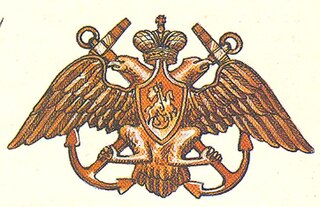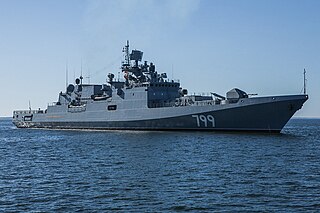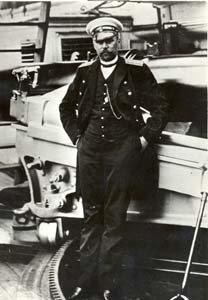
Berdiansk or Berdyansk is a port city in Zaporizhzhia Oblast, south-eastern Ukraine. It is on the northern coast of the Sea of Azov, which is connected to the Black Sea. It serves as the administrative center of Berdiansk Raion. The city is named after the Berda River's Berdiansk Spit, at the foot of which it is located. Its population is 106,311.

The Imperial Russian Navy operated as the navy of the Russian Tsardom and later the Russian Empire from 1696 to 1917. Formally established in 1696, it lasted until being dissolved in the wake of the February Revolution and the declaration of the Russian Republic in 1917. It developed from a smaller force that had existed prior to Tsar Peter the Great's founding of the modern Russian navy during the Second Azov campaign in 1696, and expanded in the second half of the 18th century before reaching its peak strength by the early part of the 19th century, behind only the British and French fleets in terms of size.

The Caspian Flotilla is the flotilla of the Russian Navy in the Caspian Sea.

The Chesapeake Bay Flotilla was a motley collection of barges and gunboats that the United States assembled under the command of Joshua Barney, an 1812 privateer captain, to stall British attacks in the Chesapeake Bay which came to be known as the "Chesapeake campaign" during the War of 1812. The Flotilla engaged the Royal Navy in several inconclusive battles before Barney was forced to scuttle the vessels themselves on August 22, 1814. The men of the Flotilla then served onshore in the defense of Washington, DC and Baltimore. It was disbanded on February 15, 1815, after the end of the war.

Krasnoye Znamya was a Soviet gunboat. The ship had been built in the late 19th century as the Khrabryy by the Russian Empire. The ship was the only craft of its class. The Krasnoye Znamya was sunk in the harbour of Lavansaari in the Gulf of Finland on November 18, 1942, after an attack by Finnish MTBs.

The Battle of the Sea of Azov, also known as the Chernigovka pocket was an Axis military campaign fought between 26 September 1941 and 11 October 1941 on the northern shores of the Sea of Azov on the Eastern Front of World War II during Operation Barbarossa. It resulted in a complete Axis victory over the Red Army.
The Iosif Stalin-class passenger ship was a two-ship class of large turbo-electric powered passenger ships, operated by the Soviet Baltic Sea Shipping Company (BGMP). The ships were taken over by the Soviet Navy during World War II and used as transport vessels. The class was named after Joseph Stalin.

The Croatian Naval Legion was a contingent of volunteers from the Independent State of Croatia that served with Nazi Germany's navy Kriegsmarine, on the Black Sea and Adriatic Sea during World War II.

The Pacific Fleet is the Russian Navy fleet in the Pacific Ocean. Established in 1731 as part of the Imperial Russian Navy, the fleet was known as the Okhotsk Military Flotilla (1731–1856) and Siberian Military Flotilla (1856–1918), formed to defend Russian interests in the Russian Far East region along the Pacific coast. In 1918 the fleet was inherited by the Russian Soviet Federative Socialist Republic, then the Soviet Union in 1922 as part of the Soviet Navy, being reformed several times before being disbanded in 1926. In 1932 it was re-established as the Pacific Fleet, and was known as the Red Banner Pacific Fleet after World War II as it had earned the Order of the Red Banner. In the Soviet years, the fleet was also responsible for the Soviet Navy's operations in the Indian Ocean and Arabian Sea. Following the collapse of the Soviet Union in 1991, the Red Banner Pacific Fleet was inherited by the Russian Federation as part of the Russian Navy and its current name was adopted.

The Azov Flotilla or Azov Naval Flotilla was the name given to several Russian naval forces operated on the Sea of Azov - as part of the Imperial Russian Navy, by both the Workers' and Peasants' Red Fleet and the White Russians during the Russian Civil War of 1917 to 1923, and as part of the Soviet Navy during World War II.
The Dnieper Flotilla is the name given to the various naval flotillas on the Dnieper River. These were particularly active in four conflicts: the Russo-Turkish wars of 1735–39 and 1787–92, the Russian Civil War, and World War II.
The Battle of Alexander Fort, was a naval battle fought in the Caspian Sea during the Russian Civil War at the naval military base of Fort Alexandrovsky.

Donbas was a Project 304 former Soviet repair ship that was converted to a command ship of the Ukrainian Navy's 9th Division. She was built on Szczecin Shipyard in Poland in 1969 for the Soviet Navy and entitled PM-9. "PM" is a Russian abbreviation for a repair ship, and literally means a floating repair shop. Donbas was destroyed during the Siege of Mariupol as a part of the 2022 Russian invasion of Ukraine.

Admiral Makarov is an Admiral Grigorovich-class frigate of the Russian Navy, part of the Black Sea Fleet based at Sevastopol. She was laid down at the Yantar Shipyard in February 2012 and commissioned on 25 December 2017. She is the most recently built of her class, and the third of six ships that had been planned in the class as of November 2014.

The Project 58155 Gyurza-M class is a series of small armored gunboats in service with the Ukrainian Navy. The first two vessels were laid down at the Kuznia na Rybalskomu shipbuilding plant in October 2012. Originally it was planned to build nine such vessels by 2017. In December 2013 the Ministry of Defence withdrew its contract. The class is named after the Levant viper, Гюрза, Hiurza, in Ukrainian.

The Monument to the Sailors of the Azov Flotilla is a historical memorial dedicated to those in the Azov Flotilla who fought in Taganrog Bay and the Don Delta during World War II. The monument is located in Azov, Rostov oblast, Russia, and is a part of the Russian Cultural Heritage Register as an object of local cultural heritage.

The Berdiansk port attack was a strike carried out by Ukrainian forces against Russian Navy ships moored in the Port of Berdiansk on 24 March 2022, during the Russian invasion of Ukraine. The Alligator-class landing ship Saratov was sunk, and one of the two Ropucha-class landing ships took damage but was able to leave the port.

Evgeny Romanovich Egoriev was a Russian Captain 1st Rank and war hero of the Russo-Japanese War. He commanded the famed Aurora during the Battle of Tsushima and despite the ship surviving the battle, he was killed along with 14 other crewmen.















